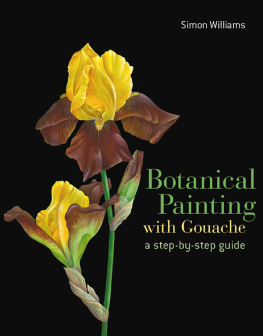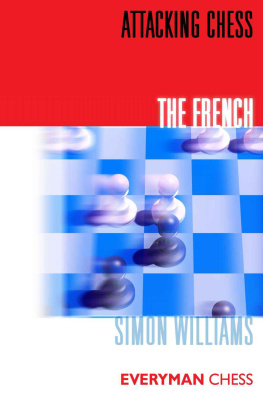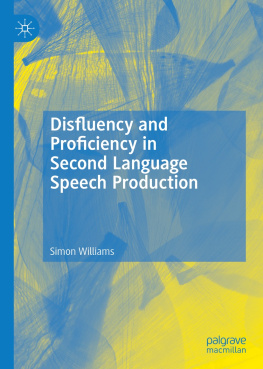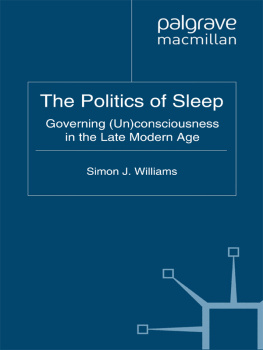Simon Williams - Chessable Grandmaster Gambits: 1. e4 By Ginger GM Simon Williams & by IM Richard Palliser
Here you can read online Simon Williams - Chessable Grandmaster Gambits: 1. e4 By Ginger GM Simon Williams & by IM Richard Palliser full text of the book (entire story) in english for free. Download pdf and epub, get meaning, cover and reviews about this ebook. genre: Home and family. Description of the work, (preface) as well as reviews are available. Best literature library LitArk.com created for fans of good reading and offers a wide selection of genres:
Romance novel
Science fiction
Adventure
Detective
Science
History
Home and family
Prose
Art
Politics
Computer
Non-fiction
Religion
Business
Children
Humor
Choose a favorite category and find really read worthwhile books. Enjoy immersion in the world of imagination, feel the emotions of the characters or learn something new for yourself, make an fascinating discovery.

- Book:Chessable Grandmaster Gambits: 1. e4 By Ginger GM Simon Williams & by IM Richard Palliser
- Author:
- Genre:
- Rating:5 / 5
- Favourites:Add to favourites
- Your mark:
- 100
- 1
- 2
- 3
- 4
- 5
Chessable Grandmaster Gambits: 1. e4 By Ginger GM Simon Williams & by IM Richard Palliser: summary, description and annotation
We offer to read an annotation, description, summary or preface (depends on what the author of the book "Chessable Grandmaster Gambits: 1. e4 By Ginger GM Simon Williams & by IM Richard Palliser" wrote himself). If you haven't found the necessary information about the book — write in the comments, we will try to find it.
Simon Williams: author's other books
Who wrote Chessable Grandmaster Gambits: 1. e4 By Ginger GM Simon Williams & by IM Richard Palliser? Find out the surname, the name of the author of the book and a list of all author's works by series.
Chessable Grandmaster Gambits: 1. e4 By Ginger GM Simon Williams & by IM Richard Palliser — read online for free the complete book (whole text) full work
Below is the text of the book, divided by pages. System saving the place of the last page read, allows you to conveniently read the book "Chessable Grandmaster Gambits: 1. e4 By Ginger GM Simon Williams & by IM Richard Palliser" online for free, without having to search again every time where you left off. Put a bookmark, and you can go to the page where you finished reading at any time.
Font size:
Interval:
Bookmark:
[Event ?] [Site ?] [Date ????.??.??] [Round ?] [White Introduction] [Black Introduction] [Result *] { Welcome to Grandmaster Gambits: 1 e4 where we present some of Simons favourite attacking and sacrificial lines! } 1. e4 e5 { In this course we tackle the big four, which means that as well as the Open Games, well be taking a good look at the ever-popular Sicilian. Against the French, 1e6 , its not so easy to gambit early on, so well settle for a space advantage with the easy-to-play Advance variation, 2.d4 d5 3.e5 . Play tends to continue 3c5 4.c3 Nc6 5.Nf3 Qb6 when we rather like 6.Bd3 and then 6cxd4 7.O-O!? , a modern twist on the famous Milner-Barry Gambit and one deployed by Magnus no less. Blacks final big four move is 1c6 , the Caro-Kann. } 2. } 2.
Nf3 Nc6 { Just so youre not stranded when Black avoids this standard choice, weve also presented lines against his alternatives, not least involving countering the Petroff, 2Nf6 , with 3.d4 . } 3. Bc4 { White goes for classic development as in this repertoire we prioritise rapid development, which a subsequent gambit will but speed up even further. } 3 Bc5 { Blacks big alternative is 3Nf6 , the Two Knights Defence, when a famous double-gambit is our plan, 4.d4!? exd4 5.O-O . } 4. d4 { Yet again the d-pawn is sacrificed to seize a strong, early initiative whichever way Black takes on d4. d4 { Yet again the d-pawn is sacrificed to seize a strong, early initiative whichever way Black takes on d4.
As for studying this course, we recommend that you should first play through the following illustrative games which introduce our key gambit lines. Do then familiarize yourself with the Quickstarter overview before undertaking some more detailed study of each variation in turn. And, above all, have fun! Indeed, these gambits, all of which have their supporters in the GM ranks, are not just decent practical weapons which should catch out plenty an opponent at an early stage, but are also most enjoyable lines to play and have in your repertoire. } * [Event ?] [Site ?] [Date ????.??.??] [Round ?] [White Introduction: Model Games] [Black Christiansen, J. vs. e4 e5 { In this course we tackle the big four, which means that as well as the Open Games, well be taking a good look at the ever-popular Sicilian. e4 e5 { In this course we tackle the big four, which means that as well as the Open Games, well be taking a good look at the ever-popular Sicilian.
Against the French, 1e6 , its not so easy to gambit early on, so well settle for a space advantage with the easy-to-play Advance variation, 2.d4 d5 3.e5 . Play tends to continue 3c5 4.c3 Nc6 5.Nf3 Qb6 when we rather like 6.Bd3 and then 6cxd4 7.O-O!? , a modern twist on the famous Milner-Barry Gambit and one deployed by Magnus no less. Blacks final big four move is 1c6 , the Caro-Kann. Here even quite experienced practitioners of that venerable opening may be stunned by 2.Bc4!? d5 3.Bb3 , Simons favorite Hillbilly Attack and every inch a gambit. } 2. Nf3 { Against Blacks classical response we recommend classical development in kind - at least for the first few moves! } 2 Nc6 3.
Bc4 { White goes for classic development as in this repertoire we prioritise rapid development, which a subsequent gambit will but speed up even further. } 3 Bc5 4. O-O { Completing our kingside development, while tucking the king away. Do observe that in contrast Blacks king is still on e8, and that actually can work to our advantage. } 4 Nf6 5. d3 followed by c3 is pretty topical, especially at the highest level, but the gambit introduced by the bold text move should really jolt your opponent awake. d3 followed by c3 is pretty topical, especially at the highest level, but the gambit introduced by the bold text move should really jolt your opponent awake.
There wont be any slow maneuvering here. } 5 Bxd4 { Blacks most popular move, playing for exchanges and aiming to keep his pawn on e5. Instead, 5exd4 6.e5 would transpose to the Max Lange Attack, named after the feared German nineteenth century attacker and theoretician. Play tends to run 6d5 7.exf6 dxc4 . Here were advocating the immediate 8.fxg7 - see our next game, Li Chao - Wang Yu. Instead, 5Nxd4? is by no means unknown, especially at club level.
However, this is a capture we should most certainly welcome: 6.Nxe5 already carries a direct threat and, perhaps unusually for 1. e4 e5 lines, castling doesnt help Black: 6O-O? fails on account of 7.Be3! . Already White is almost winning a piece, as actually happened in two games from the semi-final stage of the famed Soviet Championship! On both occasions IM and future world correspondence champion Yakov Estrin was the lucky recipient as White: 7d5! The only way to save the piece. You might wonder about 7Qe7 8.Bxd4 Bxd4 9.Qxd4 c5 , and if 10.Qc3 Nxe4 . However, after 11.Qe3 Qxe5 12.Nc3 Black nonetheless had to resign in Estrin-Klaman, Leningrad 1957, on account of 12Re8 13.Rfe1 d5 14.Bxd5 when the knight is simply dropping off. 8.exd5 b5 Fairly forced, but clearly White cannot complain about how the opening is going. 9.Bxd4 Bxd4 10.Qxd4 bxc4 11.Nc3 Bf5 12.Rac1 . 9.Bxd4 Bxd4 10.Qxd4 bxc4 11.Nc3 Bf5 12.Rac1 .
This simply left White a pawn to the good and with another set to fall on c4, and unsurprisingly he went on to win in Estrin-Ravinsky, Leningrad 1955. } 6. Nxd4 { We might have sacrificed a pawn, but are happy to trade pieces, thereby pocketing the bishop-pair while freeing the f-pawn. } 6 Nxd4 7. Bg5 { This pin is what attracted us to this line. } 7 h6 { Theres no doubt that this gambit is a good choice for fast (rapid and blitz) games, but it is also a very good choice at classical time controls too - be that at club or even the top level! Indeed, that most creative of modern-day players, Daniil Dubov, did much to reignite interest in 7. } 7 h6 { Theres no doubt that this gambit is a good choice for fast (rapid and blitz) games, but it is also a very good choice at classical time controls too - be that at club or even the top level! Indeed, that most creative of modern-day players, Daniil Dubov, did much to reignite interest in 7.
Bg5 when he deployed it in Dubov-Radjabov, Hamburg Grand Prix 2019: 7d6 8.f4 Bg4! developing with tempo; well examine Blacks alternatives in our main coverage of 1. e4 e5. 9.Bxf6! White must exchange and go in for a queen swap as 9.Qd2 is well met by the cold-blooded 9Nxe4! 9Bxd1 10.Bxd8 Rxd8 10Be2? would be clever, but not wise in view of some simple captures: 11.Bxe2 Nxe2+ 12.Kf2 . Black can avoid losing a piece, but after 12Nd4 13.Bxc7 Kd7 14.Ba5 Nxc2 15.Nc3 Nxa1 16.Rxa1 White is somewhat for choice with his two minor pieces and the d-file to attack down. 11.c3! Trying to entice Black into Nc2. If you like your minor pieces you might wish to explore 11.Rxd1!? Nxc2 12.Nc3 Nxa1 13.Rxa1 exf4 , as in two recent Sindarov-Grischuk blitz games, when Black has a lot of extra pawns, but minor piece fans might not be so unhappy as White and might start with the AlphaZerolike 14.h4!? h6 15.h5 or just go 14.
Nd5 - compare with Line A1 in our coverage of 1. e4 e5. Be2! Radjabov continues to find all the right moves, but we can imagine that many an opponent would be enticed by 11Nc2? 12.Rxd1 Nxa1 13.Na3 . However, this slams the lid on any escape by the black knight and appears to favour White: for example, 13exf4 14.Rxa1 O-O 15.Kf2! Rfe8 16.Kf3 . White makes good active use of the king and hopes to exploit Blacks weakened kingside: 16g5 17.Nb5 Re5! 18.h4! . 12.cxd4 a fairly forced capture 12Bxc4 13.Rc1 the point of Whites play 13Bd3 14.Rxc7 Rd7 the only move seen thus far in practice, sensibly overprotecting b7. 12.cxd4 a fairly forced capture 12Bxc4 13.Rc1 the point of Whites play 13Bd3 14.Rxc7 Rd7 the only move seen thus far in practice, sensibly overprotecting b7.
Instead, 14Bxe4?! 15.Nc3 would not be wise for Black, and if 15Bc6?! 16.d5 Bd7 17.Rxb7 with some advantage for White. Instead, after 14exd4 15.Rxb7 White is ready to go Nd2 and should welcome an exchange of pawns: 15Bxe4 16.Rxa7 . This nets two connected passed pawns, while it should be possible to keep the d4-pawn under control with the white knight and king. 15.Rc8+ Rd8 16.Rxd8+ If youre happy to simply repeat moves, whether in the last round of a tournament or against a much higher-rated opponent, theres also 16.Rc7 Rd7 17.Rc8+ Rd8 -, Beerdsen-Leko, German Bundesliga 2019. Kxd8 17.dxe5 17.fxe5 dxe5 18.Nc3 exd4 19.Rd1 dxc3 20.Rxd3+ Ke7 21.Rxc3 Rd8 would only leave White with an isolated e-pawn. Bxb1 18.Rxb1 .
Next pageFont size:
Interval:
Bookmark:
Similar books «Chessable Grandmaster Gambits: 1. e4 By Ginger GM Simon Williams & by IM Richard Palliser»
Look at similar books to Chessable Grandmaster Gambits: 1. e4 By Ginger GM Simon Williams & by IM Richard Palliser. We have selected literature similar in name and meaning in the hope of providing readers with more options to find new, interesting, not yet read works.
Discussion, reviews of the book Chessable Grandmaster Gambits: 1. e4 By Ginger GM Simon Williams & by IM Richard Palliser and just readers' own opinions. Leave your comments, write what you think about the work, its meaning or the main characters. Specify what exactly you liked and what you didn't like, and why you think so.













